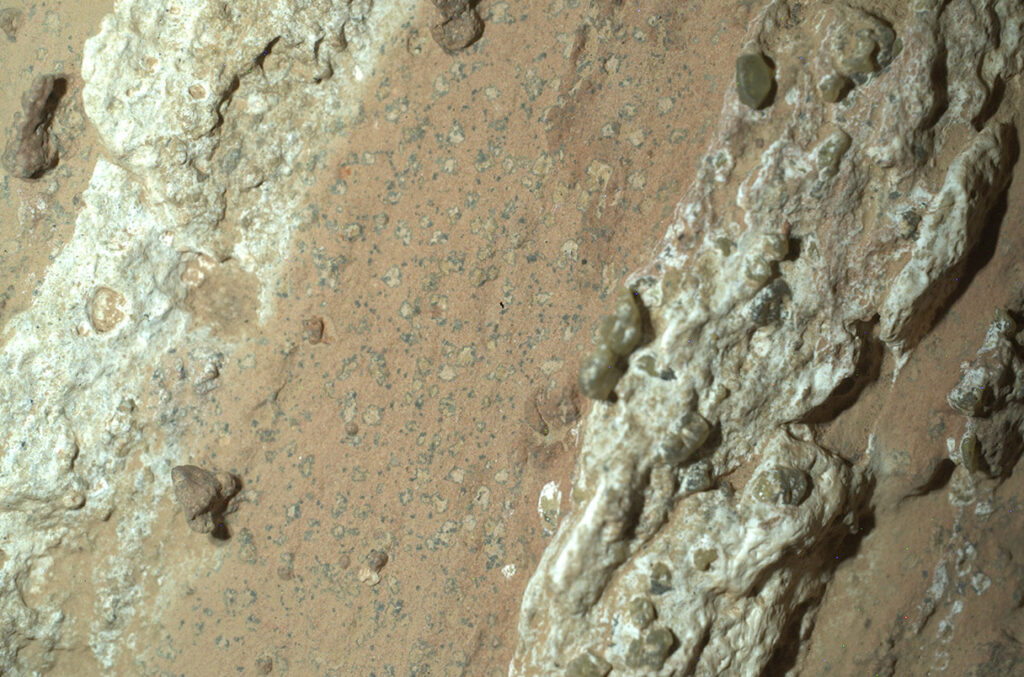
Yesterday, NASA announced that a rock spotted on Mars by its Perseverance rover contained some of the best signs yet that ancient microbial life may have once existed on the Red Planet. The rock provides clear evidence for water, organic matter, and chemical reactions that could provide an energy source, Laurie Leshin, director of the Jet Propulsion Laboratory (JPL), which operates Perseverance, posted on the social media platform X. “This is the kind of discovery you hope for — where mind-bending observations make your heart beat just a little faster,” she added.
Catch your breath, everyone. There are a lot of maybes that won’t be resolved anytime soon, if ever. And there’s a long history of martian rocks getting some of the life on our planet a little too excited.
Perhaps the most famous, or infamous, martian rock is Allan Hills 84001, a meteorite discovered in Antarctica. In a 1996 Science paper, researchers suggested it harbored nanofossils of bacteria. The news spread far and wide and even led to a congratulatory speech by then-President Bill Clinton. The debate continues, but most researchers today believe the fossillike features arose without life. Similar hype has followed rocks found by earlier Mars rovers, including Curiosity, which, with its onboard chemical lab, has detected all sorts of organic molecules during its long odyssey in Gale crater.
Perseverance lacks such an onboard lab. Its job is to drill rocks and put them in capsules that could eventually be returned to Earth for detailed study, as part of the long-planned but now stalled Mars Sample Return mission that JPL would oversee. So, its instruments are more limited than Curiosity’s. Still, they provided enough information to be excited about the Cheyava Falls rock it just drilled, taken from a site where researchers believe a river once flowed into the Jezero crater, dumping silt and creating a now-fossilized delta.

Running through the rock are white veins of calcium sulfate—minerals that precipitate out of water. Scans by a rover instrument also indicate the rock contains organic compounds. Such carbon-bearing molecules are essential building blocks of life, but they can also be formed by nonbiological processes. Perhaps most intriguing were mineral “leopard spots” in the rock, millimeter-size whitish splotches ringed by black material, which seem to contain iron and phosphate. On Earth, such spotting can form when organic molecules react with hematite, or rusted iron. These reactions, in turn, can fuel microbial life.
That’s only one explanation. Others may exist. For example, the rock also contains olivine crystals—minerals formed in volcanic eruptions that could indicate the rock was created at high temperatures no life could tolerate. But more than that, Perseverance cannot say.
This is the 22nd rock core it has collected, and many of them are intriguing to astrobiologists. Some of the cores contain mudstones or carbonate deposits that on Earth would be capable of hosting microbial life. Whether these samples will be returned to Earth for further analysis anytime soon remains in doubt. Existing plans for Mars Sample Return would have cost up to $11 billion dollars, and NASA has ordered a total rethink, requesting plans from outside companies and its research centers, including JPL, which developed the existing strategy. Until then, the program is on a barebones budget.
Although there is no doubt about the scientific value of the new sample, the provocative announcement about the rock by JPL, which is desperate not to lose Mars Sample Return funding, has raised some eyebrows. As Marc Fries, a planetary scientist at NASA’s Johnson Space Center and member of the Perseverance team, posted on X, “It should come with a conflict of interest warning sticker.”